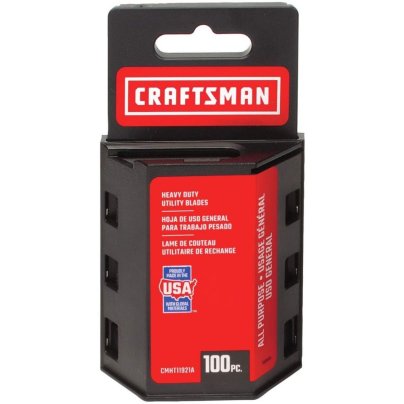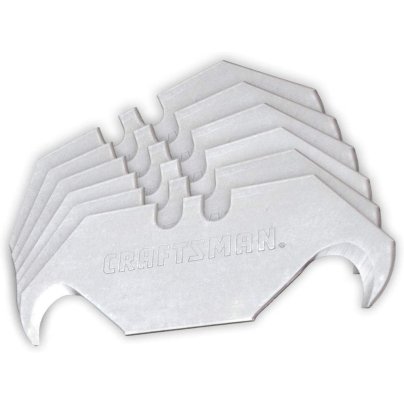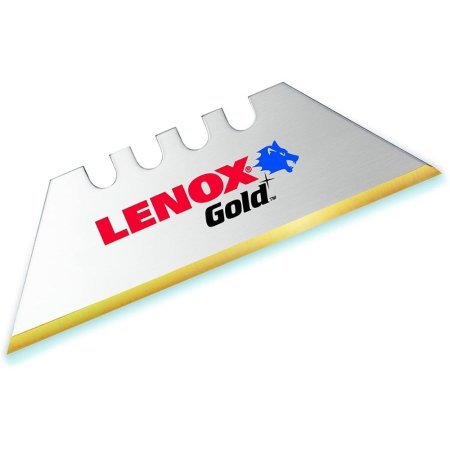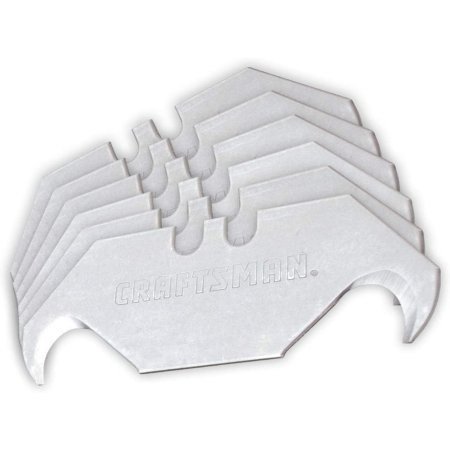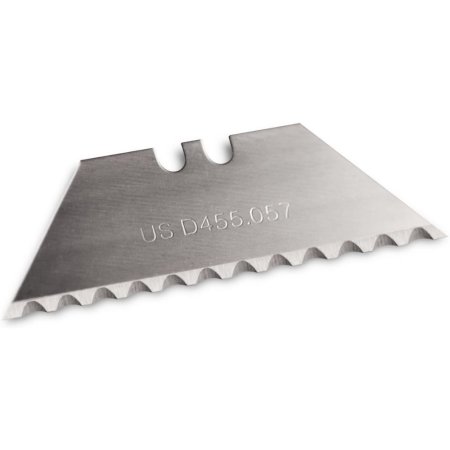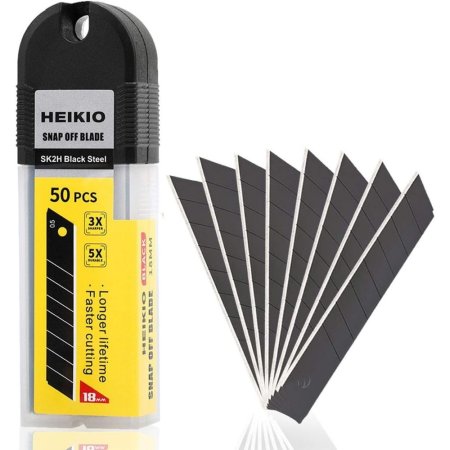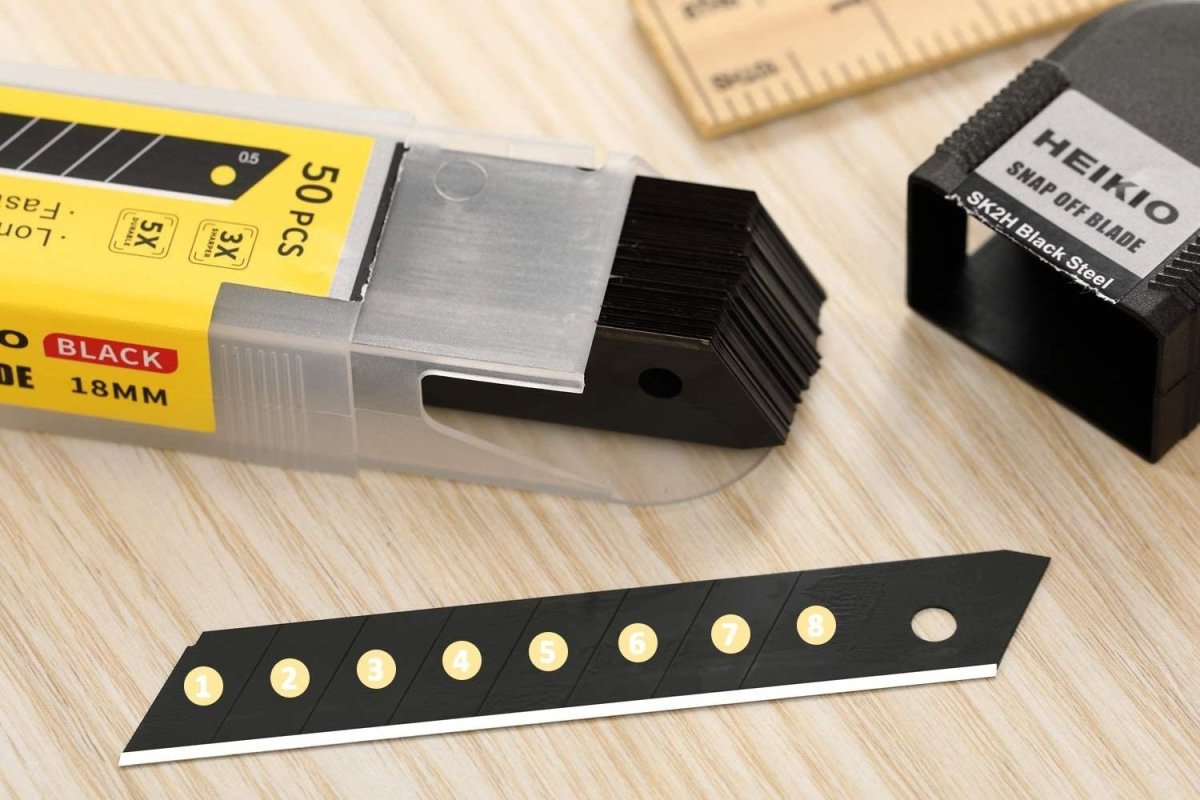
We may earn revenue from the products available on this page and participate in affiliate programs. Learn More ›
A utility knife is one of the handiest and most versatile tools to keep in a tool box. It can score drywall, slice cardboard, sharpen pencils, and tear carpet. But, it’s important to use a sharp blade to work safely and efficiently.
To give yourself that edge, keep a set of the best utility knife blades on hand. If the blade dulls or chips, you can swap in a new utility knife blade and get back to work. Not sure how to choose the best utility knife blades? This guide will explore key features to keep in mind as you shop and then dive into a selection of the top products on the market. Keep reading to learn more.
- BEST OVERALL: LENOX Utility Knife Blades, Titanium Edge, 5-Pack
- BEST BANG FOR THE BUCK: CRAFTSMAN Utility Knife Blades, 100 Pack
- BEST HOOK: CRAFTSMAN Utility Knife Blades, Hook, 50 Pack
- BEST SERRATED: Rapid Edge All-Purpose Serrated Utility Knife Blades
- BEST SNAP-OFF: HEIKIO 18mm Snap-off Blades 50-Pack
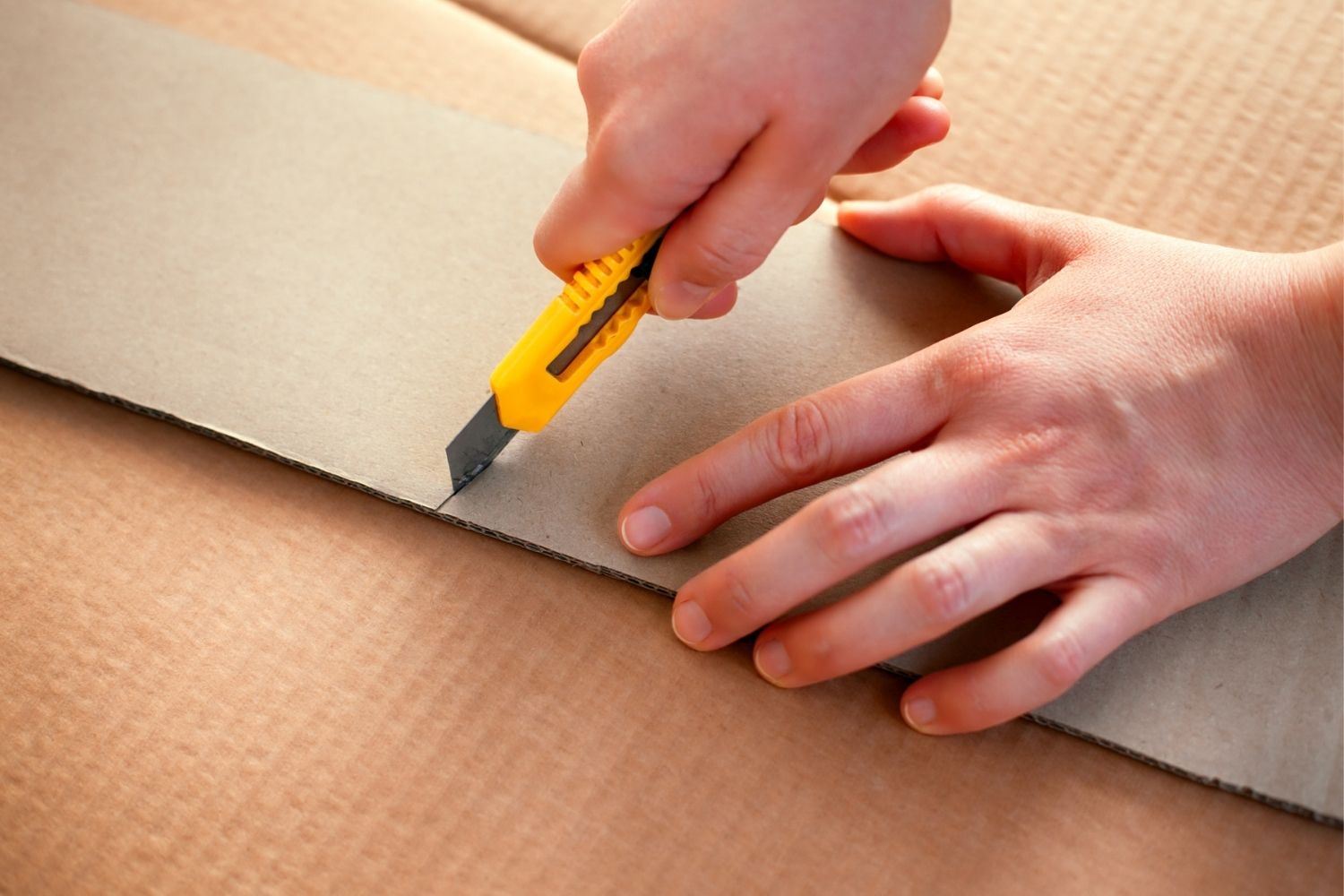
What to Consider When Choosing the Best Utility Knife Blades
Before going online to shop for a pack of the best utility knife blades, there are a few points to consider. The following sections will outline the most important considerations to keep in mind when choosing the most appropriate blades for your particular utility knife and the type of project at hand.
Material and Construction
Almost all utility knife brands use some type of carbon steel to construct their blades. Carbon steel boasts a high carbon content, which allows manufacturers to make these blades incredibly sharp. However, they aren’t very durable, as coarse materials like drywall or insulation can quickly dull the edge.
To improve durability, manufacturers will often heat-treat the blades. They bring them to extremely high temperatures, which changes the metal’s molecular structure. Also, some manufacturers treat their blades with titanium or carbide coatings so the edges will last longer. These extra steps in the manufacturing process do initially result in a higher price, but the blade will often last much longer and cost less in the long run.
Type
The best utility knife blades are available in a variety of shapes. Each type has specific jobs for which they’re most useful.
- Standard blades (pointed-tip): Standard utility knife blades are all-around, general-purpose blades. They have pointed tips that can puncture materials as well as long, straight edges for slicing. These blades are capable of almost any job, from installing drywall to slicing cardboard.
- Serrated blades: Serrated utility knife blades have teeth similar to a steak knife. These blades easily saw through sinewy materials, so they can be effective for cutting rope and other tough mediums.
- Rounded-tip blades: Rounded-tip blades are all about safety, as users are less likely to poke themselves with the tip. The trade-off is these blades are far less useful since they’re only intended for basic slicing of materials.
- Snap-off blades: Snap-off blades focus on convenience. These blades are long, with several segments along the way. When the tip of the blade dulls, users can snap it off with a pair of pliers. Also, these blades extend from the knife handle farther than other types, allowing users to slice thicker materials like Styrofoam.
- Hooked blades: As the name suggests, hooked blades feature a hook on the tip. These blades are most helpful for ripping carpet, as they hook underneath while slicing and won’t damage the underlying surface.
Versatility
As mentioned at the outset of the guide, utility knives—and specifically the blades they house—are incredibly versatile tools. Every professional trade uses a utility knife in some manner because these knives can score drywall, mark lumber, slice packaging, trim moldings, and perform a host of other useful tasks. They’re also handy during demolition to help break down large sheets of drywall, cut through caulk, slice carpets, and dismantle large cardboard boxes into more manageable pieces.
Part of what makes these blades and the knives that hold them so useful is that they’re inexpensive, and once they dull, you can throw them out. While some users might choose to resharpen the blades, their affordability and quick changes make it a matter of preference over necessity.
Our Top Picks
With a bit of background, shopping for the best utility knife blades becomes quite a bit easier. The following is a list of some of the best utility knife blades on the market to make the decision even more straightforward. Be sure to keep all of the top considerations in mind when comparing these models.
Best Overall
LENOX Utility Knife Blades, Titanium Edge, 5-Pack
Pros
- Titanium coating for sharpness
- Made with shatterproof bi-metal
- High-speed steel edge
- Four-notch design for long length
Cons
- Less blades than other available packs
Regardless of the trade or job at hand, Lenox Utility Knife Blades are up to the task. Lenox makes these blades from a high-speed steel and titanium blend, helping to ensure they remain sharp much longer than most other blades. Also, the formula gives these blades improved lateral strength, reducing the risk of snapping and chipping.
The blades are suitable for slicing through any material, including drywall, cardboard, carpet, and fabric. They’re also capable of trimming shims and moldings, as well as sharpening pencils. For thicker materials, these blades feature a four-notch design that allows them to extend farther from the knife. The blades come in a pack of five, but their durability means they can outlast much larger packs.
Best Bang for the Buck
CRAFTSMAN Utility Knife Blades, 100 Pack
Pros
- Includes 100 precision-honed pointed blades
- Pack includes dispenser for new blades
- Compatible with most utility knives
Cons
- Only includes 2 cutting lengths; best used for light cutting and trimming
When it comes to stretching a utility knife blade budget as far as it’ll go, it’s hard to overlook Craftsman’s Utility Knife Blades. This pack includes 100 pointed-tip blades, allowing users to throw them out anytime the blade becomes dull, and they fit most standard utility knives for added versatility.
Craftsman uses a special precision-honed grinding technique to put a razor-sharp edge on these blades for improved longevity and durability. This pack features a plastic dispenser that securely holds the new blades, preventing them from coming loose in a toolbox or on a workbench to increase safety.
Best Hook
CRAFTSMAN Utility Knife Blades, Hook, 50 Pack
Pros
- Precision-honed sharpness
- Hooks for precision when cutting
- 50 blades included
- Pack comes with a dispenser for new blades
Cons
- More expensive than most packs available
- Best suited for cutting thick materials
Slicing through materials like carpet, canvas, and other thick fabrics can be tough to do with a straight-tipped blade—but not for these Craftsman Utility Knife Blades. The blades feature a large hook on each end. The hook wraps underneath the material, slicing it as the user pulls the knife through. This design allows the blades to cut efficiently without scratching the surface underneath.
This pack of 50 blades comes in a plastic dispenser that holds them securely in place. Craftsman’s precision-honed edge technique ensures a sharp and durable edge on every blade. They fit any standard utility knife.
Best Serrated
Rapid Edge All-Purpose Serrated Utility Knife Blades
Pros
- Serrated edge provides friction for effective cutting
- 10 blades included
- Compatible with most utility knives available
Cons
- Not suitable for precise cutting
Friction is one of the main culprits that dulls utility knife blades—and Rapid Edge has a solution. The Rapid Edge All-Purpose Serrated Utility Knife Blades feature a serrated edge that helps to reduce friction, so they’re easier to drag through material like foam insulation and thick cardboard. With less friction comes longer life, ensuring this 10-pack of steel blades lasts as long as possible.
These blades are suitable for heavy-duty tasks for which precision isn’t the top priority. In addition to foam insulation and cardboard, they can quickly and easily slice through rope, drywall, rubber, carpet, and other tough materials. They fit most standard utility knives as well.
Best Snap-off
HEIKIO 18mm Snap-off Blades 50-Pack
Pros
- 50 blades included
- Eight snapping section for easy blade replacement
- Safe, plastic container for easy and safe storage
Cons
- Best suited for 18mm blade handles
Heikio’s Snap-off Blades are worth a look for anyone on the hunt for replacement blades for a retractable snap-off utility knife. This pack includes 50 utility blades, and each blade provides eight snappable sections, offering a fresh, clean edge whenever necessary.
These blades fit standard 18-millimeter retractable blade handles and are made from high-quality carbon steel. They’re suitable for slicing cardboard, foam insulation, leather, canvas, and many other materials around the house or job site. They also come in a plastic container with a snap-on lid, reducing the risk of these blades becoming scattered around a toolbox.
Our Verdict
Whether you are moving, re-doing your carpets, or need a strong blade for a full home renovation, the right utility knife blade can help make your project easier.
The top picks we recommend for these types of projects include the LENOX Utility Knife Blades, Titanium Edge, 5-Pack and the CRAFTSMAN Utility Knife Blades, 100 Pack for their versatility, sharpness, and compatibility with most utility knife handles.
How We Chose the Best Utility Knife Blades
After looking into the key factors that anyone should consider when purchasing a pack of utility knife blades, our top picks were selected to reflect the best options for various projects and preferences.
Many of the options above are different in style and type so you can find the right blade for certain materials including canvas, cardboard, drywall, etc. Plus, our top picks display the best of the best when it comes to versatility, quality materials, and design features.
For example, some of the options above have been precision-honed for sharpness for a sharper blade that never dulls with time. Or, another pack includes hooks for slicing if you are in need of a durable blade that can withstand thicker materials such as carpet or other thick fabrics.
No matter the project, each of the utility knife blades above is made to remain sharp through prolonged use and provide versatility throughout a number of your projects.
FAQs
Now you know a bit more about the best utility knife blades, but you might still have some questions. The following is a collection of the most frequently asked questions about these blades, so be sure to check for an answer below.
Q. What are utility blades used for?
The keyword is “versatility.” Utility blades are used for slicing cardboard, opening packages, scoring drywall, removing caulk, cutting carpets, sharpening pencils, marking wood, stripping wires, and have many, many more uses.
Q. Are utility knife blades universal?
Most utility knife blades are indeed universal. Certain shapes might not look the same, such as a hook-style blade, but they still fit standard utility knives. Keep in mind, however, that some snap-off utility knives won’t accept a standard blade.
Q. How can I change utility knife blades?
Changing the utility knife blade depends on the knife. Some utility knives have a single screw in the middle of the body. Unscrewing it provides access to the blade and allows you to swap it out. Other utility knives release the blade with a quick-change mechanism in the retracting button. Simply press it down and remove the blade from the front of the knife.
Q. How can I dispose of utility knife blades?
The most common, old-school way to dispose of a utility knife blade is to cut a slit into an empty disposable water bottle and drop it in. These bottles will easily hold a whole lot of blades before you’ll need to discard them.
Tom Scalisi is a freelance writer specializing in the home design, construction, tools, and automotive industries. He has been involved in the trades for over 15 years as both a contractor and a commercial building mechanic. In addition to his professional life, Tom enjoys getting outside on his mountain bike, camping, beekeeping, and fishing. Tom is also an avid racing and baseball fan. He lives in NY’s Hudson Valley with his wife, their three children, and three dogs.

